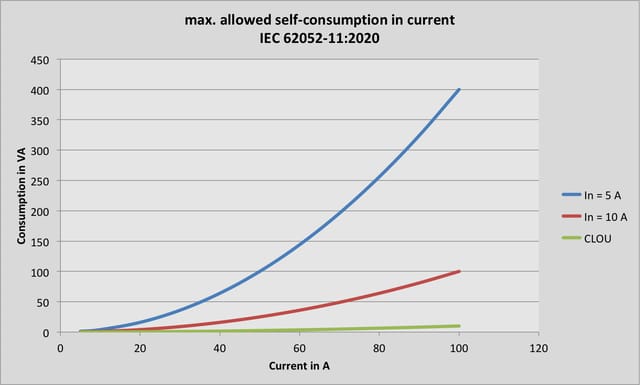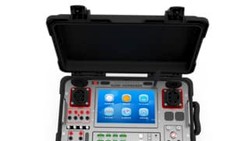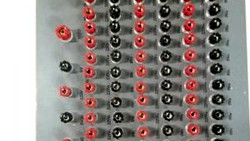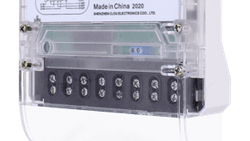The IEC 62052-11 has a tiny little detail about the power consumption in the current circuit. While the self-consumption in the voltage circuit is constant with 2 W and 10 VA, the IEC gives us for the current circuit the following statement:
Current circuit of static meters, when measured at nominal current for all classes 1 VA per phase.
Sounds not dramatically, but keep in mind that it's a non-linear function. We can calculate the maximum allowed resistance (impedance) based on the power and the nominal current.
Applying the formula R = P/I2, we get a resistance of 40 mΩ for a meter with a nominal current of 5 A respective 10 mΩ for a meter with In = 10 A.
Now we can plot the function P = I2*R.

We see an exponential increase of the self-consumption with increasing current. The blue and red lines are the allowed limits. The green line is indicating the typical value for CLOU energy meters. We are operating with an internal resistance of < 1 mΩ .
For illustration purpose, the plot shows the power consumption at 1 mΩ .
What is the impact?
Imagine, you have one million single phase energy meters in the field. All are running with a load of 10 A.
Then you need to have an additional power generation of 4 MW (based on allowed maximum for In = 5 A).
The consumption in the current circuit for the same meter quantity with CLOU meters is < 400 kW.
Conclusion
When we stick to the maximum values in IEC 62052-11, an energy meter with a higher nominal current would be the better choice in terms of self-consumption.
Back draw, the minimum starting current will be higher.
CLOU energy meters are designed for ultra-low resistance. Here it doesn't make a difference to choose In = 10 A or In = 5 A.
I would choose meters with a nominal current of 5 A , because they are starting at lower currents and are meeting the accuracy class earlier as well.
Thank you for reading and stay safe.
Editor's note: This article was originally published in August 2021 and has been updated for comprehensiveness.





Would you kindly illustrate on how do we calculate or assume consumption of a meter which has a CT ? like where do we begin to evaluate our circuit consumption of the current circuit ?
Thank you for your question. For meters with build-in CTs for current detection are untouched by this article. You can calculate with 1 VA over the whole range. For transformer operated meters, you need to calculate the burden. The main impact comes from the wiring length. For evaluation, you can use our online calculator.